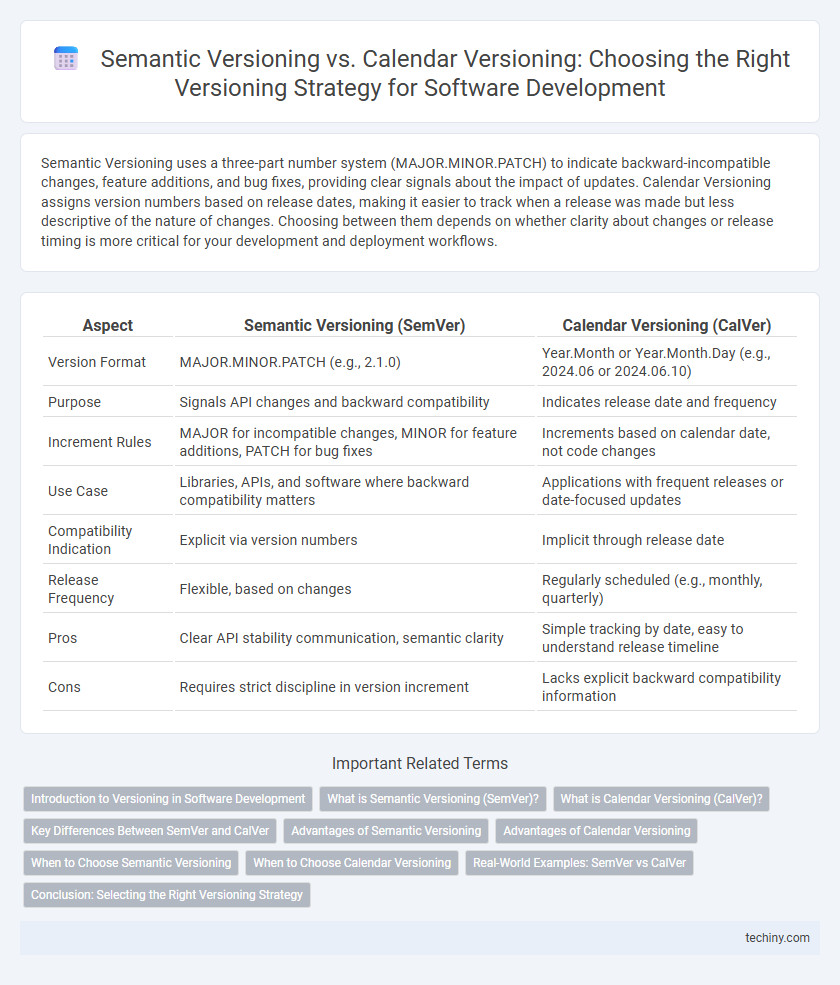Semantic Versioning uses a three-part number system (MAJOR.MINOR.PATCH) to indicate backward-incompatible changes, feature additions, and bug fixes, providing clear signals about the impact of updates. Calendar Versioning assigns version numbers based on release dates, making it easier to track when a release was made but less descriptive of the nature of changes. Choosing between them depends on whether clarity about changes or release timing is more critical for your development and deployment workflows.
Table of Comparison
| Aspect | Semantic Versioning (SemVer) | Calendar Versioning (CalVer) |
|---|---|---|
| Version Format | MAJOR.MINOR.PATCH (e.g., 2.1.0) | Year.Month or Year.Month.Day (e.g., 2024.06 or 2024.06.10) |
| Purpose | Signals API changes and backward compatibility | Indicates release date and frequency |
| Increment Rules | MAJOR for incompatible changes, MINOR for feature additions, PATCH for bug fixes | Increments based on calendar date, not code changes |
| Use Case | Libraries, APIs, and software where backward compatibility matters | Applications with frequent releases or date-focused updates |
| Compatibility Indication | Explicit via version numbers | Implicit through release date |
| Release Frequency | Flexible, based on changes | Regularly scheduled (e.g., monthly, quarterly) |
| Pros | Clear API stability communication, semantic clarity | Simple tracking by date, easy to understand release timeline |
| Cons | Requires strict discipline in version increment | Lacks explicit backward compatibility information |
Introduction to Versioning in Software Development
Semantic Versioning (SemVer) uses a three-part number format (MAJOR.MINOR.PATCH) to communicate backward-incompatible changes, new features, and bug fixes clearly. Calendar Versioning (CalVer) employs date-based numbers, such as year and month, to reflect release timing, facilitating time-oriented tracking of software updates. Both systems aim to provide transparent version history, enhancing dependency management and release predictability in software development.
What is Semantic Versioning (SemVer)?
Semantic Versioning (SemVer) is a versioning scheme for software that uses a three-part number format: MAJOR.MINOR.PATCH. Each increment signals specific types of changes--MAJOR for incompatible API changes, MINOR for backward-compatible functionality, and PATCH for backward-compatible bug fixes. SemVer enhances dependency management and version clarity by providing explicit rules for incrementing version numbers based on the nature of changes.
What is Calendar Versioning (CalVer)?
Calendar Versioning (CalVer) is a software versioning system that uses date-based identifiers, typically representing the year, month, and sometimes day of release, such as 2024.06 or 2024.06.15. This approach provides clear temporal context, making it easy to track release timelines and update recency without relying on semantic meanings. CalVer is particularly effective for projects with regular or time-driven release cycles, simplifying version management in agile and continuous deployment environments.
Key Differences Between SemVer and CalVer
Semantic Versioning (SemVer) uses a three-part number system (MAJOR.MINOR.PATCH) to indicate backward-incompatible changes, feature additions, and bug fixes, prioritizing API stability and compatibility. Calendar Versioning (CalVer) employs date-based numbering such as YYYY.MM.DD to reflect the release date, emphasizing time-based release frequency over version semantics. SemVer guides dependency management and compatibility explicitly, while CalVer facilitates predictable release cycles and easier version tracking based on time.
Advantages of Semantic Versioning
Semantic Versioning offers clear communication of software changes through its MAJOR.MINOR.PATCH format, enabling developers to understand compatibility and update impact at a glance. It facilitates dependency management by signaling breaking changes, new features, and bug fixes consistently, reducing integration risks. This structured approach improves collaboration and version control in complex development environments compared to Calendar Versioning.
Advantages of Calendar Versioning
Calendar Versioning offers clear temporal context by incorporating release dates directly into version numbers, enhancing traceability and simplifying dependency management. It enables predictable release cycles, allowing teams to plan updates and coordinate integration more effectively. This approach aligns well with continuous delivery practices, providing stakeholders with immediate insight into software recency and update frequency.
When to Choose Semantic Versioning
Semantic Versioning is ideal for software projects requiring clear communication of backward compatibility and feature changes through MAJOR.MINOR.PATCH format, ensuring developers and users can easily understand the impact of updates. It benefits libraries, APIs, and frameworks where dependency management and version constraints are critical for stability and integration. Choosing Semantic Versioning helps maintain predictable upgrade paths and reduces integration risks in complex software ecosystems.
When to Choose Calendar Versioning
Calendar Versioning is ideal for projects with regular, time-based releases where predictability and time context are prioritized over API stability. This method benefits software with frequent updates, fixed release schedules, or when communicating release timing to users is critical. It suits product cycles driven by dates rather than semantic changes in functionality or compatibility.
Real-World Examples: SemVer vs CalVer
Semantic Versioning (SemVer) utilizes a MAJOR.MINOR.PATCH format to signal compatibility and feature changes, exemplified by Node.js releasing versions like 14.17.6, where increments reflect backward-incompatible changes or bug fixes. Calendar Versioning (CalVer) adopts a date-based schema such as Ubuntu's 20.04 or Fedora's 36, providing users with explicit release timing and lifecycle expectations. Enterprises like Microsoft use SemVer for Azure SDKs to manage API stability, whereas companies like Red Hat prefer CalVer for distributions to emphasize release schedules and support windows.
Conclusion: Selecting the Right Versioning Strategy
Semantic Versioning offers clear communication of backward compatibility by incrementing major, minor, and patch versions based on changes in the software API. Calendar Versioning aligns releases with dates, enhancing predictability and marketing appeal for time-based projects. Choosing the right versioning strategy depends on project priorities such as dependency management, user expectations, and release cadence, ensuring maintainable and understandable software evolution.
Semantic Versioning vs Calendar Versioning Infographic

 techiny.com
techiny.com